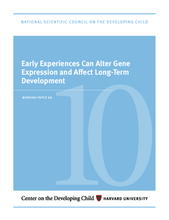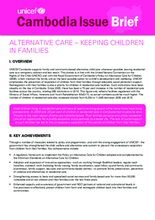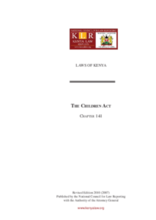Demographic Data
|
Sources: World Bank, UNICEF, UNDP HDR 2015, DHS 2013 |
Displaying 13371 - 13380 of 14555
This one-page case study describes the situation of one family in Georgia caring for their daughter with cerebral palsy and the interventions and services provided by Save the Children that enabled the family to get the support they needed to care for their daughter, and enabled the girl to improve her cognitive and motor skills.
This in-depth working paper explains how genes and the environment interact, and gives recommendations for ways that caregivers and policymakers can effectively respond to the science.
From preventative strategies to transitional and permanency solutions, the Mockingbird Family Model (MFM) offers a comprehensive support structure for families and children across the continuum of the child welfare experience. This resource briefly describes the MFM and its current activities.
This brief provides an overview of alternative care in Cambodia, including key achievements, challenges and recommended actions for preventing and regulating residential care, and strengthening family-based care.
The present volume contains the resolutions adopted by the General Assembly from 15 September to 24 December 2009, including the Guidelines for the Alternative Care of Children on page 376.
This book features individual empirical studies on the outcomes and progress made for children in foster care around the world.
Le SSI/CIR a conduit une étude sur la place de la santé des enfants adoptés dans le processus de l'adoption. Afin de brosser un tableau aussi complet que possible, des informations tirées de la pratique ont été collectées par voie de questionnaire, et différents systèmes mis en place à travers le monde ont été analysés.
Ce rapport examine les pratiques de l'adoption internationale suite au tremblement de terre en Haïti. Haïti a été un pays d'origine «populaire», en ce sens que des milliers d'enfants se trouvaient à un certain stade du processus d'adoption- parfois simplement "identifiés" comme potentiellement adoptables - au moment du séisme. Les réponses des «pays d'accueil » et autres relatives à l'adoption ultérieure des enfants déplacés à l'étranger furent diverses et contrastées.
The Children Act, Chapter 141 is a Kenyan law that addresses provision for parental responsibility, fostering, adoption, custody, maintenance, guardianship, care and protection of children; provision for the administration of children’s insti
Depuis des siècles, la situation des « orphelins » et des enfants abandonnés a généré non seulement des préoccupations, mais aussi des réponses concrètes de divers types. Ces réactions ont suscité des remises en question assez fondamentales, notamment pour ce qui est des placements en institution et, plus récemment, des justifications admissibles pour que la séparation des enfants d’avec leurs parents soit avalisée, voire imposée, par les autorités.






